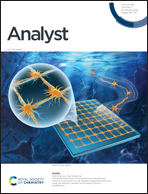Acid-etched Fe/Fe2O3 nanoparticles encapsulated into carbon cloth as a novel voltammetric sensor for the simultaneous detection of Cd2+ and Pb2†
Abstract
A portable electrode with usability, availability, and high-sensitivity is of great significance for effective on-site detection in practical situations. In this paper, a novel flexible, disposable sensor for Cd2+ and Pb2+ with ultrahigh sensitivity and a fast response, based on acid-etched Fe/Fe2O3 encapsulated into a disposable carbon cloth electrode, has been successfully fabricated. Differential pulse anode stripping voltammetry (DPASV) was used to investigate the stripping behavior of Cd2+ and Pb2+, achieving high sensitivity for Cd2+ and Pb2+ (338.7 and 408.0 μA mM−1 cm−2) with limits of detection (LODs) of 0.42 ppb and 0.50 ppb, respectively. Meanwhile, remarkable stability and reproducibility were obtained. Such an electrode can detect Cd2+ and Pb2+ in actual water samples so this is a good candidate to act as a simple and convenient sensor for general applications. More importantly, the novel disposable electrode exhibited the unique advantages of convenience, portability, and reliability compared to a conventional electrode, which may make it an alternative advantageous choice for practical on-site detection.



 Please wait while we load your content...
Please wait while we load your content...